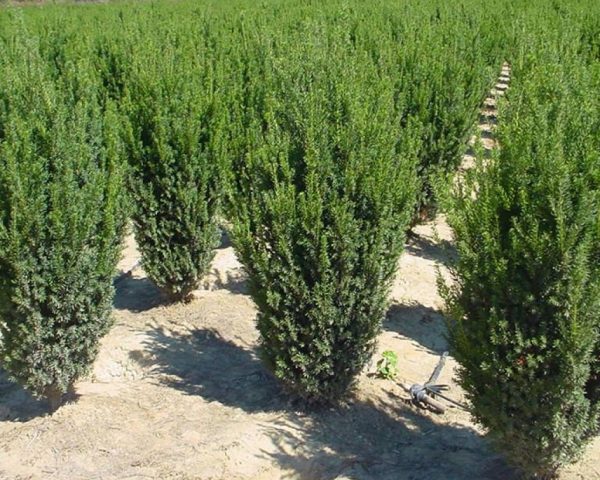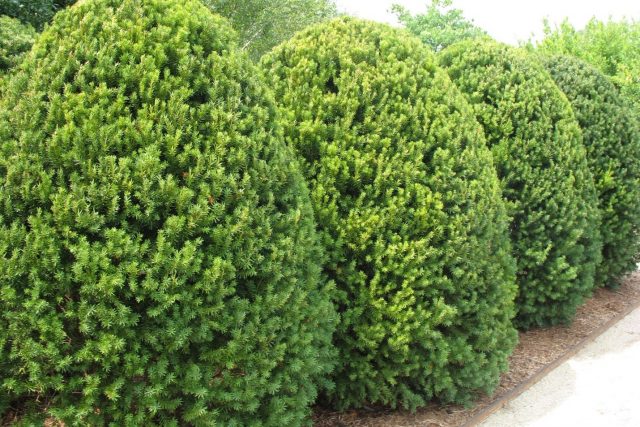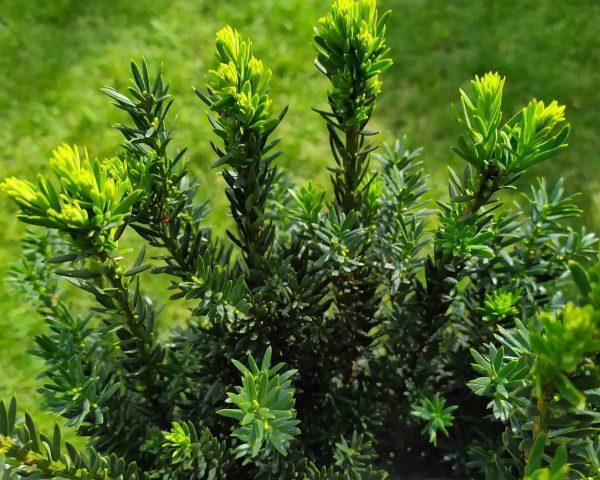Content
Medium yew Hilli (Hillii) is one of the most popular varieties used for decorative landscaping. This is explained by its ability to look great as part of any composition, thanks to the dense columnar shape of the crown. In addition, the plant has a high vital potential and is undemanding to care.

Hilly is shade-tolerant
Description of Hilly yew with photo
This coniferous plant is a hybrid obtained by crossing pointed and berry yew. American breeders worked on its creation. The hybrid was officially registered in 1914 and was named Hillii. After this it went into production.
Yew average Hilli is a wide-pyramidal large shrub with a densely branched crown. The plant is evergreen. Its branches are directed strictly vertically. The side shoots of the conifer are short. With age, they become vase-like and intertwine with each other, which improves the decorative effect of the perennial.
The needles are needle-shaped, short-pointed. Above it is a light green shade, shiny, and below it has a gray tint.The length of the needles reaches 2-2.2 cm, and the width is 2.5 mm.
Tiss middle Hilli is a male form of culture. Its flowers are bell-shaped, white-pink in color, collected in spherical inflorescences. This hybrid does not produce fruits. The flowering period begins at the end of April, at the beginning of May.

Yew average Hilli - poisonous plant
Height and dimensions of Hilly yew
This variety has medium vigor. The height of an adult Hilli yew reaches 3-3.5 m, and the diameter of the crown growth is about 1.5 m. The annual growth is 10-15 cm. At the age of ten, the height of the tree reaches 1.5 m.
Advantages and disadvantages
This hybrid has many advantages, which explains the increased demand for its seedlings. However, ephedra also has disadvantages that must be taken into account when choosing it.

Hilly is well suited for small garden areas
Main advantages:
- unpretentiousness;
- shade tolerance;
- highly decorative;
- tolerates pruning well;
- undemanding to soil composition;
- quickly adapts to a new place;
- goes well with other cultures.
Flaws:
- does not bear fruit;
- average growth rate;
- needs shelter for the winter at an early stage of development.
Planting a middle hilly yew
Yew medium Hilli can be planted in the spring, as well as throughout the summer if conditions are favorable. To do this, it is necessary to purchase seedlings with a closed root system without signs of disease.
For planting, you need to prepare holes up to 1 m deep and 50 cm wide. A 10 cm thick drainage layer should be laid at the bottom, and the rest of the space should be filled with nutritious soil mixture.It should consist of turf, sand, peat and humus in a ratio of 2:1:1:1. You also need to add 100 g of superphosphate and 70 g of potassium sulfide to the substrate and mix thoroughly.
Planting of the middle Hilly yew should be carried out according to the standard scheme. Upon completion, the root collar of the seedling should be at soil level.
Caring for medium yew Hilly
The hybrid belongs to the category of undemanding crops, and therefore requires minimal care.
It is necessary to water the middle Hilly yew only at the initial stage of growth; subsequently the tree builds up a powerful root system and independently provides itself with moisture. Moisturizing should be done once a month, pouring 10-15 liters of water under the conifer. During hot periods, the plant requires washing the needles by sprinkling, as it prefers high air humidity.
It is recommended to fertilize the middle Hilly yew twice a season from the second year after planting. The first fertilizing should be done in the spring, using nitroammophoska 50-150 g. The plant should be fertilized a second time at the end of August. During this period, you can use 60-120 g of superphosphate and 50-80 g of potassium sulfide. Fertilizer granules must be scattered into the root circle and then embedded in moist soil.
Medium Hilly yew needs periodic pruning. It is necessary to maintain the correct shape of the crown, as well as to remove broken and damaged branches. It is recommended to carry out the procedure in the spring.
Despite the frost resistance of the species at -27 °C, its young seedlings need shelter for the winter.Therefore, in late spring, at the base of the conifers, you need to lay a layer of peat or humus 10 cm thick, then tie the branches with twine and cover the crown with spruce branches.

Medium yew Hilli acquires frost resistance as it matures
Pest and disease control
The hybrid has high natural immunity. But inappropriate growing conditions lead to a decrease in its stability.
Yew medium Hilli can be affected by Phoma. In this case, gray-brown spots appear on the trunk, which subsequently crack. This negatively affects the decorativeness of the crown.

For the prevention and treatment of phomosis, it is recommended to use Bordeaux mixture
The most common pests that damage the hybrid are the needle beetle and the weevil. If damaged, the needles lose their natural shine, and the appearance of the bush becomes depressing. To destroy pests, it is recommended to use Fufanon or Actellik.
Conclusion
Medium yew Hilli is a shrub that can fit perfectly into any landscape design. Its compact size allows the plant to be used in any area, successfully combining with other crops. At the same time, the plant is long-lived and unpretentious. It is only necessary to provide proper care at the initial stage so that the conifer can grow a lush, beautiful crown.








